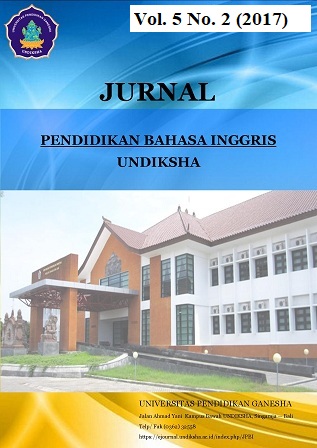AN ANALYSIS OF JARGON USED BY RECEPTIONISTS IN FRONT OFFICE AT VILLA SEMANA RESORT AND SPA UBUD
DOI:
https://doi.org/10.23887/jpbi.v5i2.12121Abstract
Penelitian ini bertujuan untuk mengidentifikasi dan menggambarkan bentuk-bentuk linguistik, makna, dan fungsi jargon yang digunakan oleh resepsionis di kantor depan di Villa Semana Resort and Spa Ubud. Jargon yang digunakan oleh resepsionis dianalisis masing-masing dengan menggunakan teori Allan & Burridge (2006) yang didukung oleh teori Yule's (2006), dan teori Chaer & Agustina (2010). Penelitian ini dilakukan dengan metode qulitatif. Jargon kantor depan diselidiki dalam bentuk lisan dan tulisan mereka. Subjek penelitian ini adalah resepsionis di departemen front office di Villa Semana Resort and Spa Ubud. Metode pengumpulan data adalah observasi, wawancara, dan dokumentasi. Studi ini menemukan bahwa 186 jenis jargon digunakan oleh resepsionis di kantor depan. Ditemukan bahwa jargon dalam bentuk frase kata benda dengan jumlah total 60 item (32,3%), kata benda 40 item (21,6%), singkatan 29 item (15,6%), kata kerja 13 item (7%), pinjaman 12 item (6,5%), afiksasi 8 item (4,3%), kata sifat 6 item (3.2%), kliping 4 item (2,2%), akronim 3 item (1,6%), koin 3 item (1,6%), frase preposisi 3 item (1,6%), konversi 2 item (1%), frase kata 2 item (1%), dan pencampuran 1 item (0,5%). Arti dari 186 jargon diidentifikasi dengan menyelidiki makna teknis. Selain itu, penelitian ini menemukan bahwa ada dua fungsi jargon. Pertama, menyediakan bahasa spesialis teknis untuk membuat komunikasi lebih efisien. Kedua, hal itu mendorong solidaritas kelompok.Kata Kunci : jargon, resepsionis, departemen front office, vila semana resort dan spa ubud
This study aimed at identifying and describing the linguistic forms, the meanings, and the functions of jargons used by receptionists in front office department at Villa Semana Resort and Spa Ubud. The jargons used by the receptionists were analyzed respectively using Allan & Burridge’s (2006) theory which is supported by Yule’s (2006) theory, and Chaer & Agustina’s (2010) theory. This study was conducted in qulitative method. The front office jargons were investigated in their spoken and written forms. The subjects of this study were receptionists of the front office department at Villa Semana Resort and Spa Ubud. The methods of data collection were observation, interview, and documentation. This study found that 186 types of jargon were used by receptionists in front office department. It was found that the jargons were in the form of noun phrase with the total number of 60 items (32.3%), noun 40 items (21.6%), abbreviation 29 items (15.6%), verb 13 items (7%), borrowing 12 items (6.5%), affixation 8 items (4.3%), adjective 6 items (3.2%), clipping 4 items (2.2%), acronym 3 items (1.6%), coinage 3 items (1.6%), preposition phrase 3 items (1.6%), conversion 2 items (1%), verb phrase 2 items (1%), and blending 1 item (0.5%). The meanings of 186 jargons were identified by investigating technical meaning. Besides, this study found that there were two functions of the jargons. First, it provides a technical specialist language to make communication more efficient. Second , it encourages group solidarity.
keyword : jargon, receptionist, front office department, villa semana resort and spa ubud
Published
2017-10-25
Issue
Section
Articles
License
Authors who publish with the Jurnal Pendidikan Bahasa Inggris Undiksha agree to the following terms:- Authors retain copyright and grant the journal the right of first publication with the work simultaneously licensed under a Creative Commons Attribution License (CC BY-SA 4.0) that allows others to share the work with an acknowledgment of the work's authorship and initial publication in this journal
- Authors are able to enter into separate, additional contractual arrangements for the non-exclusive distribution of the journal's published version of the work (e.g., post it to an institutional repository or publish it in a book), with an acknowledgment of its initial publication in this journal.
- Authors are permitted and encouraged to post their work online (e.g., in institutional repositories or on their website) prior to and during the submission process, as it can lead to productive exchanges, as well as earlier and greater citation of published work. (See The Effect of Open Access)













